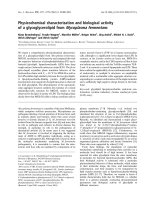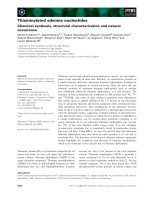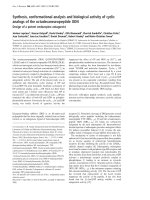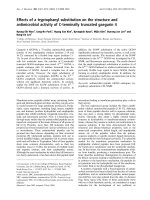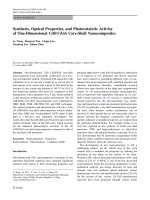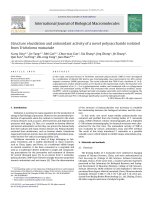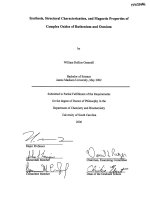Novel vic-dioximes: synthesis, structure characterization, and antimicrobial activity
Bạn đang xem bản rút gọn của tài liệu. Xem và tải ngay bản đầy đủ của tài liệu tại đây (1.54 MB, 11 trang )
Turkish Journal of Chemistry
Turk J Chem
(2021) 45: 1873-1881
© TÜBİTAK
doi:10.3906/kim-2104-24
/>
Research Article
Novel vic-dioximes: synthesis, structure characterization, and antimicrobial activity
evaluation
1
1
1,
Dumitru URECHE , Ion BULHAC , Alexandru CIOCARLAN *,
1
1
1,2
Daniel ROSHCA , Lucian LUPASCU , Paulina BOUROSH
1
Institute of Chemistry, Chisinau, Republic of Moldova
2
Institute of Applied Physics, Chisinau, Republic of Moldova
Received: 07.04.2021
Accepted/Published Online: 15.08.2021
Final Version: 20.12.2021
Abstract: The vic-dioximes are compounds with various industrial uses and scientific applications. Many coordination compounds
have been synthesized based on vic-dioximes. This study presents the synthesis and full characterization of two vic-dioximes based
on dichloroglyoxime, p-aminobenzoic acid, and p-aminotoluene. Their structures were proved by IR, 1H, 13C and 15N NMR spectral
analysis, and single crystal X-ray diffraction. One of the reported vic-dioximes, bis(di-p-aminotoluene)glyoxime mono-p-aminotoluene
trihydrate showed good to moderate antimicrobial activity against both nonpathogenic gram-positive and gram-negative bacteria
(Bacillus subtilis and Pseudomonas fluorescens), phytopathogenic (Xanthomonas campestris, Erwinia amylovora, E. carotovora) and the
fungi (Candida utilis and Saccharomyces cerevisiae) at MIC – 70–150 μg/mL.
Key words: vic-dioxime, spectral analysis, X-ray diffraction, antibacterial activity, antifungal activity
1. Introduction
vic-Dioximes are widely used as general industrial chemical compounds [1], analytical reagents [2,3], model for biological
system [4–7], as well as catalysts in various chemical processes [8,9]. Since the early 1900s vic-dioximes have been
used extensively as chelating agents in coordination chemistry [10-13]. Even today vic-dioximes and their complexes
constitutes an important class with a versatile reactivity [6,8]. Due to the position of two oximic groups, these compounds
can exist as three stereoisomeric forms: anti-(E,E), amfi-(E,Z) and sin-(Z,Z), which also influence the modality of metal
coordination. The most common is the N-N-chelation coordination mode favored by the anti-(E,E) form [6,13,14], but
the coordination of these ligands via oxygen atoms from oximic groups is also known [15,16]. vic-Dioximes can form
coordination compounds in molecular [17,18], monodeprotonated [19-22] and bis-deprotonated [23] forms. In the
coordinated state the intramolecular hydrogen bonds between the oxime anions can be replaced with boron compounds
(BF2+, BF2+, B(C6H5)2+, B(OH)2+), thus, encapsulating the respective compounds [24–27]. In the literature, are described the
vicinal dioximes containing either aliphatic or aromatic amines [28–34], for which creation the dichloroglyoxime (DClH2)
can be used as a precursor. Also, starting from dichloroglyoxime, a new dioximic ligand was synthesized by condensation
with the thiolic derivative - octane-1-thiol, and, based on the obtained dioxime, a Ni-(II) complex was synthesized [35].
The condensation reaction of amines or thiols with dichloroglyoxime leads to the formation of different di-, tetra-,
poliamino-derivatives or substituted thioglyoximes [17,36]. Through such kind of reactions, a series of new dioximes have
been synthesized [17,37–39]. Both, the oxime and coordination compounds obtained based on their basis show a wide
range of pharmacological activities, including antibacterial, antifungal and antidepressant [40–42].
The purposes of this work were the synthesis of new vic-dioxime ligands by the condensation of dichloroglyoxime with
p-aminobenzoic acid (paba) and p-aminotoluene (pat), their structure elucidation using modern methods of analysis and
biological activity assessments against seven strains of nonpathogenic and phytopatogenic bacteria and fungi.
2. Materials and methods
2.1. Materials
All the reactions were conducted at the room temperature or a moderate heating. All the reagents were purchased from
Merck and Aldrich and were used without further purification unless noted otherwise.
*Correspondence:
This work is licensed under a Creative Commons Attribution 4.0 International License.
1873
URECHE et al. / Turk J Chem
2.2. Methods
Melting points (m.p.) were measured on a Boetius hot stage and are uncorrected. Infrared spectra (IR) were recorded
on a FTIR Spectrum-100 Perkin Elmer spectrometer in Nujol (400–4000 cm–1) and using ATR technique (650–4000
cm–1). The UV-Vis spectra were recorded in methanol on a Perkin Elmer Lambda 25 spectrometer (400–4000 nm), at a
concentration of compounds 1 and 2 (c = 0,33·10–5 mol/L and c = 0,23·10–5 mol/L). 1H, 13C and 15N NMR spectra were
recorded in DMSO-d6 (99.95 %) on a Bruker Avance DRX 400 (400.13, 100.61 and 40.54 MHz). Chemical shifts (d) are
reported in ppm and are referenced to the residual nondeuterated solvent peak (2.50 ppm for 1H and 39.50 ppm for 13C).
Coupling constants (J) are reported in Hertz (Hz). The following abbreviations were used to explain the multiplicities: s =
singlet, d = doublet, t = triplet, q = quartet, qvin. = quintet, sex = sextet, m = multiplet, brs = broad singlet. X-ray analyses
on single crystal were performed on a Xcalibur E diffractometers with a CCD detector using graphite-monochromatized
MoKα radiation at room temperature.
2.3. Synthesis
2.3.1. Synthesis of bis(p-aminobenzoic acid)-glyoxime hydrate [H4L1]·H2O (1)
The yellow solution resulted after dissolving of dichloroglyoxime (0.31 g, 0.02 mol) and p-aminobenzoic acid (0.55 g, 0.04
mol) in MeOH (10 mL) was stirred for 15 min. Then, to the reaction mixture, consecutively, Na2CO3 (0.21 g, 0.02 mol)
was added and after 15 min H2O (3 mL) was added with additional stirring for 2 h. As result, a radish-yellow sediment was
obtained, then filtered through a glass filter and washed, consecutively, with MeOH and Et2O. After drying, a beige product
(0.395 g, 56%) soluble in DMF and DMSO was obtained. The filtrate has been passed into a chemical beaker and allowed
to crystallize at room temperature. After six days, yellowish needle shaped crystals were obtained. m.p. 281–284 °C. Anal.
Calcd. for C16H16N4O7 (376.23): (430.09): C, 51.07; H, 4.28; N, 14.89. Found: C, 50.93; H, 4.30; N, 14.79. IR (nmax/cm-1):
3535 (ν(OH)H2O), 3180 (ν(OH)oxime+ ν(NH)), 1677 (ν(C=O)), 1652 (ν(C=N)), 1600, 1519, 1459 (ν(C=C)), 854 (δ(CH)arom.
). 1HNMR (400.13 MHz, DMSO-d6, ppm): d 10.92 (l.s., 2H, CO2H), 8.75 (s, 2H, NH), 7.66 (d, J=8.8 Hz, 4H, C2-C6,
nonplan.
C2ʹ-C6ʹ), 6.82 (d, J=8.8 Hz, 4H, C3-C5, C3ʹ-C5ʹ). 13CNMR (100.61 MHz, DMSO-d6, ppm) d 167.6 (COOH), 144.55 (C4, C4ʹ),
142.32 (C8, C9), 130.45 (C2-C6, C2ʹ-C6ʹ), 123.19 (C1, C1ʹ), 117.92 (C3-C5, C3ʹ-C5ʹ). 15NNMR (40.54 MHz, DMSO-d6, ppm):
d 100.9.
2.3.2. Synthesis of bis(di-p-aminotoluene)-glyoxime mono-p-aminotoluene trihydrate [(H2L2)2] pat·3H2O (2)
The yellow solution resulted after dissolving of dichloroglyoxime (0.31 g, 0,02 mol) and p-aminotoluene (0.48 g, 0,04 mol)
in EtOH (10 mL) was stirred for 15 min. Then, to the reaction mixture, consecutively, Na2CO3 (0.21 g, 0.02 mol) was added
and after 15 min H2O (3 mL) was added. The reaction mixture was heated at 50 °C for 40 min until complete carbonate
dissolving, then heating was stopped and it was stirred for 1.5 h. As result, a white coloured sediment was obtained, then
filtered through a glass filter and washed with Et2O. After drying, it was obtained a beige product (0.78 g, 53%) soluble
in DMF, MeOH, EtOH, DMSO and insoluble in H2O. The filtrate has been passed into a chemical beaker and allowed
to crystallize at room temperature. After one week, radish needle shaped crystals were obtained. m.p. 205–207 °C. Anal.
Calcd. for C39H51N9O7 (757.89):C, 61.80; H, 6.78; N, 16.64. Found: C, 61.93; H, 6.71; N, 16.72. IR (nmax/cm-1): 3676 (ν(OH)
), 3371 (νas(NH2)), 3308 (νs(NH2)), 3187 (ν(NH)), 1614 (δ(NH2)), 1516, 1452, 1407 (ν(C=C)), 812 (δ(CH)arom.nonplan.).
oxime
1
HNMR (400.13 MHz, DMSO-d6, ppm) d 10.36 (l.s., 2H, >N-OH), 8.44 (s, 2H, NH), 6.88 (d, J=8.4 Hz, 4H, C3-C5, C3ʹC5ʹ), 6.67 (d, J=8.4 Hz, 4H, C2-C6, C2ʹ-C6ʹ), 2.16 (s, 6H, 2xC7,7ʹ-H3). 13CNMR (100.61 MHz, DMSO-d6, ppm) d 143.56 (C1,
C1ʹ), 137.43 (C8, C9), 131.05 (C4, C4ʹ), 129.26 (C3-C5, C3ʹ-C5ʹ), 119.77 (C2-C6, C2ʹ-C6ʹ), 20.64 (C7, C7ʹ). 15NNMR (40.54 MHz,
DMSO-d6, ppm): d 97.1.
2.4. Microbiological activity assessments
Antimicrobial activity evaluation of both compounds was performed on the following microorganisms: nonpathogenic
gram-positive and gram-negative strains of Bacillus subtilis NCNM BB-01 (ATCC 33608) and Pseudomonas fluorescens
NCNM PFB-01 (ATCC 25323), respectively, and phytopathogenic strains of Xanthomonas campestris NCNM BX-01
(ATCC 53196), Erwinia amylovora NCNM BE-01 (ATCC 29780), E. carotovora NCNM BE-03 (ATCC 15713), as well on
the fungi strains of Candida utilis NCNM Y-22 (ATCC 44638) and Saccharomyces cerevisiae NCNM Y-20 (ATCC 4117).
Before the evaluation of the antimicrobial activity of the compounds 1 and 2 the microbial cell viability assessment was
done on the used microorganisms. Moreover, this assessment is performed periodically and mandatory in the process of
maintaining the microorganisms in the collection.
For testing the double successive dilution method was used as reported before [43]. For this, at the initial stage, 1 mL of
peptone broth for test bacteria and Sabouraud broth for test fungi was introduced into a series of 10 tubes. Subsequently,
1 mL of the analyzed preparation was dropped into the first test tube. Then, the obtained mixture was pipetted, and 1 mL
of it was transferred to the next tube, so the procedure was repeated until tube no. 10 of the series. Thus, the concentration
1874
URECHE et al. / Turk J Chem
of the initial preparation decreased 2-fold in each subsequent tube. At the same time, 24 h test microorganisms cultures
were prepared. Initially, suspensions of test microorganisms were prepared with optical densities (O.D.) of 2.0 for tested
bacteria and 7.0 for fungi according to the McFarland index. Subsequently, 1 mL of the obtained microbial suspension
was dropped in a tube containing 9 mL of sterile distilled water. The content of the tube was mixed, and 1 mL of the
mixture was transferred to tube no. 2 of the 5-tube series containing 9 mL of sterile distilled water. From the 5-th tubes
of the series, 0.1 mL of the microbial suspension was taken, which represent the seeded dose and added to each tube with
titrated preparation. Subsequently, the tubes with titrated preparation and the seeded doses of the microorganisms were
kept in the thermostat at 35 °C for 24 h. On the second day, a preliminary analysis of the results was made. The last tube
from the series in which no visible growth of microorganisms has been detected is considered to be the minimal inhibitory
concentration (MIC) of the preparation. For the estimation of the minimal bactericidal and fungicidal concentrations,
the contents of the test tubes with MIC and with higher concentrations are seeded on peptone and Sabouraud agar from
Petri dishes with the use of the bacteriological loop. The seeded dishes are kept in the thermostat at 35 °C for 24 h. The
concentration of preparation, which does not allow the growth of any colony of microorganisms, is considered to be the
minimal bactericidal and fungicidal concentrations of the preparation.
2.5. Crystallographic studies
Determination of the unit cell parameters and processing of experimental data were performed using the CrysAlis Oxford
Diffraction Ltd. (CrysAlis RED, O.D.L. Version 1.171.34.76. 2003). The structures were solved by direct methods and
refined by full-matrix least-squares on weighted F2 values for all reflections using the SHELXL2014 suite of programs [44].
All non-H atoms in the compounds were refined with anisotropic displacement parameters. The positions of hydrogen
atoms in the structures were located on difference Fourier maps or calculated geometrically and refined isotropically in
the “rigid body” model with U = 1.2Ueq or 1.5Ueq of corresponding O, N, and C atoms. Crystallographic data and structure
refinements are summarized in Table S1, and the details of the hydrogen bonding interactions are given in Table S2. CCDC
2051228 and 2051229 contain the supplementary crystallographic data for this paper. These data can be obtained free
of charge via www.ccdc.cam.ac.uk/data_request/cif, or by emailing , or by contacting The
Cambridge Crystallographic Data Centre, 12, Union Road, Cambridge CB2 1EZ, UK; fax: +44 1223 336033.
3. Results and discussion
The syntheses of target compounds were performed by interaction of dichloroglyoxime (DClH2) with p-aminobenzoic
acid (paba) and p-aminotoluene (pat), in 1:2 molar ratio, in methanol and ethanol, respectively, according to Scheme.
The new vic-dioxime bis(p-aminobenzoic acid)-glyoxime hydrate (H4L1·H2O, 1) and bis(di-p-aminotoluene)-glyoxime
HO 2C
2
1
6
3
NH
paba
C
Cl
C
DClH 2
7
C
-2HCl
OH
Cl
5'
4'
5 4
8
N OH
[H 4 L ]·H2 O
N
(1)
HO N
OH
N OH
C
pat
-2HCl
2
7
H3 C
3
1 6
NH
4
5
2'
C
1
+
3'
HN
HO N
N
CO2 H
6' 1'
7
C
8
HN
4' 5'
3'
2'
[(H2 L2 )2 ]·L3 ·3H2 O (2)
6'
1'
7
CH 3
Scheme. Synthesis of vic-dioximes 1 and 2.
1875
URECHE et al. / Turk J Chem
mono-p-aminotoluene trihydrate ((H2L2)2·pat·3H2O, 2) were obtained in 56% and 53% yields, and their structures were
confirmed by spectral IR, 1H, 13C and 15N NMR analyses and single crystal X-ray diffraction.
3.1. FT IR and UV-Vis spectroscopy
The region 3800–2400 cm–1 from the IR spectrum of compound 1 is the most informative and shows multiple strong
absorption bands. The absorption maximum from 3535 cm–1 may be attributed to the ν(OH)H2O vibration with the
formation of hydrogen bonds [45], and narrow band from 3361 cm–1 as the first overtone of the ν(C=O) group vibration
[46]. The presence of oximic OH group is confirmed by a large peak at 3180 cm–1, which is typical also for ν(NH), the value
and the width of which proves the association of both mentioned groups by hydrogen bonds [45,47]. Also, the signal from
1626 cm–1 belongs to the δ(NH) vibrations of amino group.
A series of middle intensity absorption bands (in the range 3100–2700 cm–1) may be attributed to the ν(CH) vibrations
of the aromatic rings, and their intensity higher than usual is caused by the relatively large number of aromatic rings in the
complex [45]. The ν(C=C) vibrations at 1600, 1519 and 1459 cm–1, but also δ(CH)nonpl. oscillation from 854 cm–1 represents
1,4-substituted aromatic rings (two neighboring hydrogen atoms) [45,48].
The spectrum of compounds 2 has many similarities with that of compound 1, but it has also some differences related
to the absence of the carboxylic group and presence of –CH3 group from oxime and –NH2 group from molecule of
p-aminotoluene, which co-crystallizes with oxime molecule. The main vibrations characteristic for amino group νas(NH2)
and νs(NH2) are visible at 3371 and 3308 cm–1, respectively, and that of δ(NH2) is present at 1614 cm–1. The signals of
the aliphatic groups (–CH3) are located in the range of 3000–2700 cm–1, as well as those for δas(CH3) and δs(CH3) at
1466 and 1380 cm–1, respectively. The IR spectrum of compound 2 contains some strong absorption bands specific for
dimeric carboxylic acids whose –OH groups form hydrogen bonds of O-H…O type at 2672 and 2531 cm–1 [43]. The peak
of ν(C=O) groups is well seen at 1677 cm–1, this of ν(C-O)+δ(OH)plan. groups at 1421 cm–1 and δ(OH)nonpl. from dimer
at 898 cm–1. The signal of ν(C=N)oxime is visible at 1652 cm–1 [44]. The vibration from 812 cm–1 proves the presence of
1,4-substituted aromatic rings (two neighboring hydrogen atoms) [45].
In the UV-Vis spectra of dioximes 1 and 2, acquired in methanol, two pairs of absorption maximums are observed at
225 and 230 nm, 295 and 340 nm, respectively. First peaks can be assigned to π→π* type transactions in benzene ring (C=C
bonds) and to azomethine groups (-C=N) from the oximic unit (Figure 1) [49]. The second pair of peaks represent n→π*
type transactions characteristic for iminic groups (-C=N:-) and carbonyl groups (-C=O:) [49, 50].
3.2. NMR characterization
The NMR analysis fully confirmed the structure of compounds 1 and 2. Thus, the doublets from 6.82 and 7.66 ppm belong
to unsubstituted protons from aromatic rings of ligand 1. The protons from NH groups appeared at 8.75 ppm and those
from oximic groups at 10.92 ppm, all as large singlets. The tertiary carbon atoms from aromatic rings were registered at
a)
Figure 1. Molecular structure of compounds 1 (a) and 2 (b).
1876
b)
URECHE et al. / Turk J Chem
117.92 and 130.45 ppm, quaternary at 123.19 and 144.55 ppm. The signal of carbons from carboxylic and oximic groups
is localized at 142.32 and 167.60 ppm.
According to NMR data, the unsubstituted aromatic protons from the molecule of compound 2 are visible at 6.67 and
6.88 ppm. The protons of methyl groups appear at 2.15 ppm and those from NH groups at 8.43 ppm, all as singlets. The
protons from oximic groups were registered as large singlet at 10.36 ppm. The tertiary carbons from aromatic rings were
registered at 119.77 and 129.26 ppm, while quaternary at 131.05 and 143.56 ppm. The signals from 137.43 ppm belongs to
oximic carbon atoms.
The 15N NMR spectra of compounds 1 and 2 contain the signals of aminic N atoms at 100.9 ppm and 97.1 ppm,
respectively.
3.3. Single crystal structures
The recent literature review in CSD [51] revealed that only two polymorphs of dianylineglyoxime salts as uncoordinated
dioxime with “aromatic wings” are known [17]. We reported new di-аminobenzoylglioxime compounds 1 and 2 with
substituents –COOH and –CH3 in para-positions crystallized in centrosymmetric C2/c (1) and uncentered Pn (2)
monoclinic space groups (Table S1).
In the asymmetrical part of the unit cell of the crystal 1 a molecule of H4L1 and water were detected, and in that of
crystal 2 - two molecules of H2L2, one crystallization molecule of 4-methylaniline (p-toluidine) L3 and three molecules
of water, as a result their formulas, can be described as H4L1·H2O and (H2L2)2·L3·3H2O (Figures 1a and 1b). It should be
mentioned, that the title compounds were never reported before. A careful search in CSD showed a Fe(II) complex with
ligand, which contains two fragments of methylated dianylineglyoxime being united by three BF2+ moieties [25,52]. In
CSD there are nine cases when p-aminotoluene crystallizes with diverse molecules, inclusive derivatives of 4-nitrophthalic
acid or of 3,3’-(pentane-1,5-diylbis(oxy))-bis-(5-methoxybenzoic) acid with pat [53, 54].
Due the fact that these neutral molecules possess both proton donor groups and acceptor atoms, in respective crystals,
the components are connected by complicated system of hydrogen bonds (Table S2). In the crystal of compound 1 can be
highlighted chains parallel with plane b, formed by synthons R(8)22 via –COOH groups of neighboring H2L (Figure 2a),
which further develops into a 3D network via oximic groups and water molecules (Figure 3a).
In the crystal of compound 2 three water molecules unite four molecules of H2L2 and one of pat (Figure 2b), which
further develops in parallel chains with a, united via fine C-H...X bonds, where X is the center of the aromatic ring from
molecule pat (C...X 3.625, H...X 3.087 Å) (Figure 3b).
3.4. Antimicrobial activity
A detailed literature search in the field of biological activity of vic-dioximes offered a few related bibliographic references.
In one of them, the authors reported that, in contrast to its metal CuII, NiII, ZnII, CdII complexes, vic-dixime ligand bearing
a)
b)
Figure 2. Fragment of chains in 1 (a) and view of H-bonded components in 2 (b).
1877
URECHE et al. / Turk J Chem
one naphthyl disodium disulfonate unite has no inhibitory effects on the growth of Rhodotorula rubra, Kluyveromyces
marxianus, Aspergillus fumigatus and Mucor pusillus fungi strains [41].
Another research group performed an in vitro assessments of some 3- and 4-substituted benzaldehyde hydrazones
vic-ligands and their CuII, NiII, CoII complexes on 18 strains of bacteria and yeasts [55]. The authors mentioned that all
the tested compounds exhibit moderate antimicrobial activities, the ligands being generally more active. Here must be
mentioned mono-3-methylbenzaldehyde hydrazone vic-dioxime, followed by mono-4-methoxybenzaldehyde hydrazone
vic-dioxime. These ligands have shown slightly higher activities against Bacillus thrungiensis and strong activity against
Candida utilis, C. albicans, C. glabata, C. trophicalis, Saccharomyces cerevisiae compared to the reference compounds.
A comparative study of the antibacterial activity of two vic-dioxime ligands containing one p-tolyl and benzylpiperazinyl, and bis-benzyl-piperazinyl radicals and their NiII, CuII, CoII, ZnII metal complexes was performed by authors
[56]. According to them only ligand bearing bis-benzyl-piperazinyl units have shown weak antibacterial activity.
The in vitro growth inhibitory activity of the vic-dioxime [H4L1]·H2O 1 and [H2L2]·pat·3H2O 2 ligands was assessed
against both nonpathogenic gram-positive and gram-negative bacteria (Bacillus subtilis and Pseudomonas fluorescens),
phytopathogenic (Xanthomonas campestris, Erwinia amylovora, E. carotovora) and the fungi (Candida utilis and
Saccharomyces cerevisiae) (Table).
Compound 2 exhibits average antibacterial and antifungal properties in the range of concentrations of 70–150 μg/
mL for bacteria and fungi. In contrast to other vic-dioxime ligands that do not show antibacterial and antifungal activity
a)
b)
Figure 3. Fragments of crystal packing in 1 (a) and 2 (b) along b.
Table. In vitro antifungal and antibacterial activities of compound 1 and 2.
MBC and MFC, mg/mL
Compd
Bacillus
subtilis
Pseudomonas
fluorescens
Erwinia
amylovora
Erwinia
carotovora
Xanthomonas
campestris
Candida
Utilis
Saccharomuces
cerevisiae
1
N/A
N/A
N/A
N/A
N/A
N/A
N/A
2
70
150
70
150
150
70
150
MBC – minimal bactericidal concentration;
MFC - minimal fungicidal concentration;
N/A – non active
1878
URECHE et al. / Turk J Chem
compared to their metal complexes [41, 57], we managed to obtain reported ligands in crystalline form and in higher
yields using simple but efficient methods of synthesis. Looking to the data presented in Table, it is well seen that compound
2 exhibits variable biological activity depending on the bacterial or fungicidal species. A possible cause of this variation
could be the different permeability of the cells of the microorganism or the difference between the ribosomes of the
microbial cells [58–61]. In order to avoid speculation about the influence of the co-crystallized p-aminotoluene molecule
on the activity of compound 2, a separate evaluation was performed on said bacterial and fungal strains. According to this,
p-aminotoluene did not show antimicrobial activity.
A probable explanation of the different activity of compound 1 and 2 may be the presence of different substituents in
the benzene ring, otherwise their structure being identical. The inactivity of compound 1 may be due to the presence of
the carboxyl group in the para-position of the benzene ring, make this compound highly hydrophilic and, consequently,
decrease the cell membrane penetration. In the case of compound 2, the situation is different; the presence of the methyl
group in the para-position of the benzene ring increase the lipophilic nature of this compound, and consequently increase
its cell membrane penetration capacity.
4. Conclusion
As result of this research bis(p-aminobenzoic acid)-glyoxime hydrate and bis(di-p-aminotoluene)glyoxime monop-aminotoluene trihydrate were synthetized and fully characterized, including by single crystal X-ray diffraction.
The last reported compound showed good antimicrobial activity against five species of gram-positive, gram-negative,
phytopatogenic bacteria, and two strains of fungi. The reported data are a good contribution to the chemistry of vicdioximes, and the compounds obtained are promising ligands for the synthesis of metal complexes.
Acknowledgement
This work was supported by State Programs of National Agency for Research and Development R. Moldova 20.80009.5007.28.
and 20.80009.5007.15.
LL is grateful to National Collection of Non-Pathogenic Microorganisms (NCNM) of the Institute of Microbiology
and Biotechnology.
References
1.
Kanno H, Yamamoto H. Production method of organic solvent solution of dichloroglyoxime. EP 0.636.605A1 1994.
2.
Banks CV. The chemistry of vic-dioximes. Record of Chemical Progress 1964; 25: 85-103.
3.
Singh RB, Garg BS, Singh RP. Oximes as spectrophotometric reagents – a review. Talanta 1979; 26 (6): 425-444. doi: 10.1016/00399140(79)80107-1
4.
Serin S. New vic-dioxime transition metal complexes. Transition Metal Chemistry 2001; 26: 300-306. doi: 10.1023/A:1007163418687
5.
Schrauzer GN, Windgassen RJ, Kohnle J. Die Konstitution von Vitamin B12s Chemische Berichte 1965; 98 (10): 3324-3333. (in German). doi:
10.1002/cber.19650981032
6.
Chakravorty A. Structural chemistry of transitional metal complexes of oximes. Coordination Chemistry Reviews 1974; 13 (1): 1-46. doi:
10.1016/S0010-8545(00)80250-7
7.
Lance KA, Dzugan S, Busch DH, Alcock NW. The synthesis, characterızatıon and dıoxygen affınıty of pıllared cobalt complexes derıved from
the glyoxımato lıgand famıly. Gazzetta Chimica Italiana 1996; 126 (4): 251-258. SICI-code: 0016-5603(1996)126:4
8.
Boyer JH. Increasing the index of covalent oxygen bonding at nitrogen attached to carbon. Chemical Reviews 1980; 80: 495-561. doi: 10.1021/
cr60328a002
9.
Schrauzer GN, Kohnle J. Coenzym B12-Modelle. Chemische Berichte 1964; 97 (11): 3056-3064. (in German). doi: 10.1002/cber.19640971114
10. Tschugaeff L. Über eine neue synthese der α-diketone. Berichte der deutschen chemischen Gesellschaft 1907; 40 (1): 186-187. (in German).
doi: 10.1002/cber.19070400127
11. Canpolat E, Kaya M. Synthesis and formation of a new vic-dioxime complexes. Journal of Coordination Chemistry 2005; 58 (14): 1217-1224.
doi: 10.1080/00958970500130501
12. Kukushkin VY, Pombeiro AJL. Oxime and oximate metal complexes: unconventional synthesis and reactivity. Coordination Chemistry
Reviews 1999; 181 (1): 147-175. doi: 10.1016/s0010-8545(98)00215-x
13. Forster MO. LVIII.—Studies in the camphane series. Part XI. The dioximes of camphorquinone and other derivatives of isonitrosocamphor.
Journal of the Chemical Society, Transaction 1903; 83 (9): 514-536. doi: 10.1039/ct9038300514
1879
URECHE et al. / Turk J Chem
14. Canpolat E, Kaya M. Synthesis, characterization of some Co(III) complexes with vic-dioxime ligands and their antimicrobial properties.
Turkish Journal of Chemistry 2004; 28 (2): 235-242.
15. Chen X-Y, Cheng P, Liu X-W, Yan S-P, Bu W-M. et al. Binuclear and tetranuclear copper(II) complexes bridget by dimethylglyoxime.
ChemistryLetters 2003; 32 (2): 118-119. doi: 10.1246/cl.2003.118
16. Simonov YA, Malinovskii ST, Bologa OA, Zavodnik VE, Andrianov VI. et al. Crystalline and molecular structure of μ-Oxo-di (bisdimethylglyoxymethocobalt (III)). Crystallography 1993; 28: 682-684.
17. Ureche D, Bulhac I, Rija A, Coropceanu E, Bourosh P. Dianilineglyoxime salt and its binuclear Zn(II) and Mn(II) complexes with
1,3-benzenedicarboxylic acid: synthesis and structures. Russian Journal Coordination Chemistry 2019; 45 (2): 843-855. doi: 10.1134/
S107032841912008X
18. Bourosh P, Bulhac I, Simonov YuA, Gdaniec M, Turta K et al. Structure of the products formed in the reaction of cobalt chloride with
1,2-cyclohexanedione dioxime. Russian Journal of Inorganic Chemistry 2006; 51 (8): 1202-1210. doi: 10.1134/S0036023606080092
19.
Takamura T, Harada T, Furuta T, Ikariya T, Kuwata S. Half-sandwich iridium complexes bearing a diprotic glyoxime ligand: Structural diversity
induced by reversible deprotonation. Chemistry an Asian Journal 2020; 15 (1): 72-78. doi: 10.1002/asia.201901276
20. Bourosh P, Bologa O, Deseatnic-Ciloci A, Tiurina J, Bulhac I. Synthesis, structure, and biological properties of mixed cobalt(III) dioximates
with quinidine derivatives. Russian Journal Coordination Chemistry 2017; 43 (9): 591-599. doi: 10.1134/S1070328417090019
21. Coropceanu E, Bologa O, Arsene I, Vitiu A, Bulhac I et al. Synthesis and characterization of inner-sphere substitution products in azidecontaining cobalt(III) dioximates. Russian Journal Coordination Chemistry 2016; 42 (8): 516-538. doi: 10.1134/S1070328416070046
22. Bulhac I, Bouros PN, Bologa OA, Lozan V, Ciobanic O et al. Specific features of the structures of iron(II) α-benzyl dioxymate solvates with
pyridine. Russian Journal of Inorganic Chemistry 2010; 55 (7): 1042-1051. doi: 10.1134/S0036023610070090
23. Galinkina J, Wagner C, Rusanov E, Merzweiler K, Schmidt H et al. Synthesis und charakterisierung von 2-O-punktionalisierten
ethylrhodoximen und – cobaloximen. Journal of Inorganic and General Chemistry 2002; 628 (11): 2375-2382. (in German). doi:
10.1002/1521-3749(200211)628:11<2375::AID-ZAAC2375>3.0.CO;2-Qn
24. Coșkan A, Karapinar E. Synthesis of N-(4’-Benzo-[15-crown-5]) thiophenoxyphenylaminoglyoxime and its complexes with some transition
metals. Journal of Inclusion Phenomena Macrocyclic Chemistry 2008; 60 (1-2): 59-64. doi: 10.1007/s10847-007-9352-x
25. Belov AS, Prikhod’ko AI, Novikov VV, Vologzhanina AV, Bubnov YN et al. First ”Click” synthesis of the ribbed-functionalized metal
clathrochelates: cycloaddition of benzyl azide to propargylamine iron(II) macrobicycle and the unexpected transformations of the resulting
cage complex. European Journal of Inorganic Chemistry 2012; 2012 (28): 4507-4514. doi: 10.1002/ejic.201200628
26. Jansen JC, Verhage M, van Koningsveld H. The molecular structure of bis(N-methylimidazole)-bis(diphenylboron-dimethylglyoximato)
iron(II) FeC40N8O4B2H442CCl2H2. Crystal Structure Communications 1982; 11 (1): 305-308.
27. Fedder W, von Schnering HG, Umland F. Über die struktur von bis- dihydroxoboroxalendiamid-dioximato)-nickel(II) – tetrahydrat. Journal
of Inorganic and General Chemistry 1971; 382 (2): 123-134. (in German). doi: 10.1002/zaac.19713820204
28. Yari A, Kakanejadifard A. Spectrophotometric and theoretical studies on complexation of a newly synthesized vic-dioxime derivative with
nickel(II) in dimethylformamide. Journal of Coordination. Chemistry 2007; 60 (10): 1121-1132. doi: 10.1080/00958970601110469
29. Chertanova LF, Yanovskii AI, Struchkov YuT, Sopin VF, Rakitin OA et al. X-Ray structural investigation of glyoxime derivatives. I. Molecular
and crystal structure of amino- and diaminoglyoximes. Journal Structural Chemistry 1989; 30 (1): 129-133. doi: 10.1007/BF00748195
30. Kakanejadifard A, Amani V. (2Z, 3Z)-3,4-Dihydro-2H-1,4-benzothiazine-2,3-dione dioxime dehydrate. Acta Crystallographica Section E
2008; E64 (8): o1628. doi: 10.1107/S1600536808023301
31. Kakanejadifard A, Sharifi A, Delfani F, Ranjbar B, Hossein N. Synthesis of di and tetraoximes from the reaction of phenylendiamines with
dichloroglyoxime. Iranian Journal of Chemistry and. Chemical Engineering 2007; 26 (4): 63-67. doi: 10.30492/IJCCE.2007.7602
32. Endres H, Schendzielorz M. Basic behovior of oxamide dioxime: structures of di(oxamide dioximium) squarate, 2C2H7N4O2+·C4O42- (I), and of
axamide dioximium di(hydrogen squarate), C2H8N4O22+·2C4HO4- (II). Acta Crystallographica Section C 1984; c40 (3): 453-456. doi: 10.1107/
S0108270184004492
33. Yuksel F, Gürek AG, Durmuș M, Gurol I, Ahsen V et al. New insight in coordonation of vic-dioximes: Bis- and tris(E,E-dioximato)Ni(II)
complexes. Inorganica Chimica Acta 2008; 361: 2225-2235. doi: 10.1016/j.ica.2007.11.019
34.
Kilic A, Tas E, Yilmaz I. Synthesis, spectroscopic and redox properties of the mononuclear NII, NII(BPh2)2 containing (B-C) bond and trinuclear
CII-NiII-CuII type-metal complexes of N,N’-4-amino-1-benzyl piperidine)-glyoxime. Journal of Chemical Sciences 2009; 121 (1): 43-56. doi:
10.1007/s12039-009-0005-z
35. Gurol I, Gumus G, Yuksel F, Jeanneau E, Ahsen V. Bis[N,N’-bis(octylsulfanyl)glyoximato]nickel(II). Acta Crystallographica Section E 2006;
E62: m3303-3305. doi: 10.1107/S1600536806046605
36. Coburn MD. Picrylamino-substituted heterocycles. II. Furazans(1,2). Journal of Heterocyclic Chemistry 1968; 5 (1): 83-87. doi: 10.1002/
jhet.5570050114
1880
URECHE et al. / Turk J Chem
37. Kakanejadifard A, Khajehkolaki A, Ranibar B, Hossein NM. Synthesis of new dioximes and tetraoximes from reaction of aminothiophenoles
with dichloroglyoxime. Asian Journal of Chemistry 2008; 20 (4): 2937-2946.
38. Grundmann C, Mini V, Dean JM, Frommeld H-D. Über nitriloxyde, IV. Dicyan-di-N-oxyd. Justus Liebigs Annalen der Chemie 1965; 687 (1):
191-214. doi: 10.1002/jlac.19656870119
39. Rija A, Bulhac I, Coropceanu E, Gorincioi E, Calmỵc E et al. Synthesis and spectroscopic study of some coordinative compounds of Co(III),
Ni(II) and Cu(II) with dianiline- and disulfanilamideglyoxime. Chemistry Journal of Moldova 2011; 6 (2): 73-78. doi: 10.19261/cjm.2020.795
40.
Babahan İ, Anil H, Sarikavakli N. Synthesis of novel tetraoxime derivative with hydrazine side groups and its metal complexes. Turkish Journal
of Chemistry 2011; 35 (4): 613-624. doi: 10.19261/cjm.2020.795
41.
Kurtoğlu M, İspir E, Kurtoğlu N, Serin S. Novel vic-dioximes: Synthesis, complexation with transition metal ions, spectral studies and biological
activity. Dyes and Pigments 2008; 77 (1): 75-80. doi: 10.1016/j.dyepig.2007.03.010
42. Roppoport Z, Liebman JF. The chemistry of Hydroxylamines, Oximes and Hydroxamic Acids. England. Wiley, 2009.
43. Ciocarlan A, Dragalin I, Aricu A, Lupascu L, Ciocarlan N et al. Chemical composition and antimicrobial activity of the Levisticum officinale
W.D.J. Koch essential oil. Chemistry Journal of Moldova 2018; 13 (2): 63-68. doi: 10.19261/cjm.2018.514
44.
Sheldrick GM. Crystal structure refinement with SHELXL. Acta Crystallographica Section C 2015; C71 (1): 3-8. doi: 10.1107/S2053229614024218
45. Bellamy LJ. Infrared spectra of complex molecules. New York, USA. Wiley, 1954.
46. Tarasevich BN. IR spectra of the main classes of organic compounds. Reference materials. Moscow, Russia. Izdatel’stvo inostrannoi literaturi
2012. (in Russian)
47. Gordon AJ, Ford RA. The chemist’s companion. A handbook of practical data, techniques and references. New York-London-Sydney-Toronto,
Wiley Interscience 1972.
48. Nakanishi K. Infrared absorption spectroscopy. Tokyo, Japan. Holden Day 1962.
49.
Kilic A, Tas E, Gumgum B, Yilmaz I. Synthesis, spectral characterization and electrochemical properties of new vic-dioxime complexes bearing
carboxylate. Transition Metal Chemistry 2006; 31 (5): 645-652. doi: 10.1007/s11243-006-0043-z
50. Fraser C, Bosnich B. Bimetallic reactivity. Investigation of metal-metal interaction in complexes of a chiral macrocyclic binucleating ligand
bearing 6- and 4-coordinate sites. Inorganic Chemistry 1994; 33 (2): 338-346. doi: 10.1021/ic00080a024
51. Allen FH. The Cambridge Structural Database: a quarter of a million crystal structures and rising. Acta Crystographica Section B 2002; B58
(3): 380-388. doi: 10.1107/S0108768102003890
52. Varzatskii OA, Voloshin YZ, Korobko SV, Shulga SV, Kramer R et al. On a way to new types of the polyfunctional and polytopic systems based
on cage metal complexes: cadmium-promoted nucleophilic substitution with low-active nucleophilic agents. Polyhedron, 2009; 28 (16): 34313438. doi: 10.1016/j.poly.2009.07.026
53. Colaỗo M, Dubois J, Wouters J. Mechanochemical synthesis of phthalimides with crystal structures of intermediates and products. Crystal
Engineering Communications 2015; 17 (12): 2523-2528. doi: 10.1039/C5CE00038F
54. Kohmoto S, Kuroda Y, Kishikawa K, Masu H, Azumaya I. Generation of square-shaped cyclic dimers vs zigzag hydrogen-bonding networks
and pseudoconformational polymorphism of tethered benzoic acids. Crystal Growth & Design 2009; 9 (12): 5017-5020. doi: 10.1021/
cg901244v
55. Babahan I, Poyrazoğlu Çoban E, Ưzmen A, Biyik H, Isman B. Synthesis, characterization and biological activity of vic-dioxime derivatives
containing benzaldehydehydrazone groups and their metal complexes. African Journal of Microbiology Research 2011; 5 (3): 271-283.
56. Bilge T, Uğur A. Preparation and spectral and biological investigation of vic-dioxime ligands containing piperazine moiety and their
mononuclear transition-metal complexes. Synthetic Communications 2013; 43 (24): 3307-3314. doi: 10.1080/00397911.2013.777743
57. Uğur A, Mercimek B, Özler MA, Șahin N. Antimicrobial effects of bis(∆2-2-imidazolinyl)-5,5’-dioxime and its mono- and tri-nuclear
complexes. Transition Metal Chemistry 2000: 25(4): 421-425. doi: org/10.1023/A:1007064819271
58. Kurtoğlu M, Dagdelen MM, Toroğlu S. Synthesis and biological activity of novel (E,E)-vic-dioximes. Transition Metal Chemistry 2006; 31 (3):
382-388. doi: 10.1007/s11243-006-0006-4
59. Sengupta SK, Pandey OP, Srivastava BK, Sharma VK. Synthesis, structural and biochemical aspects of titanocene and zirconocene chelates of
acetylferrocenyl thiosemicarbazones. Transition Metal Chemistry 1998; 23 (4): 349-353. doi: org/10.1023/A:1006986131435
60. Kurtoğlu M, Baydemir SA. Studies on mononuclear transition metal chelates derived from a novel (E,E)-dioxime: synthesis, characterization
and biological activity. Journal of Coordination Chemistry 2007; 60 (6): 655-665. doi. org/10.1080/00958970600896076
61. İspir E, Kurtoğlu M, Toroğlu S. The d10 metal chelates derived from schiff base ligands having silane: synthesis, characterization and
antimicrobial studies of cadmium(II) and zinc(II) complexes. Synthesis and Reactivity in Inorganic, Metal-Organic and Nano-Metal Chemistry
2006; 36 (8): 627-631. doi: org/10.1080/15533170600910553
1881
URECHE et al. / Turk J Chem
Table S1. Crystal data and structure refinement for compounds 1 and 2.
1
2
Formula
C16H16N4O7
C39H51N9O7
Mr
376.33
757.89
Cryst. system
monoclinic
monoclinic
Space group
C2/c
Pn
а/Å
35.338(2)
13.863(2)
b/Å
6.8836(4)
6.4122(14)
с/Å
14.3090(9)
23.213(5)
b/°
106.419(7)
99.512(18)
V, Å3
3338.7(4)
2035.1(7)
Z
8
2
Dcalcd / g/c
1.497
1.237
μ / mm-1
0.120
0.087
F(000)
1568
808
Crystal size / mm3
0.40 x 0.08 x 0.04
0.50 x 0.06 x 0.04
Reflections collected / independent reflections
5258/2938
(Rint = 0.0312)
7811/5837
(Rint = 0.0682)
Completeness to theta / % (θ = 25.05)
99.3
99.8
Parameters
244
510
Goodness-of-fit on F
1.004
1.007
final R1, wR2
R1 = 0.0522,
wR2 = 0.1174
R1 = 0.0737,
wR2 = 0.1349
R indices (all data)
R1 = = 0.0890,
wR2 = 0.1315
R1 = 0.2073,
wR2 = 0.1988
Largest diff. peak and hole, e×Å-3
0.263, –0.292
0.233, –0.214
2
1
URECHE et al. / Turk J Chem
T able S2. Hydrogen bond distances (Å) and angles (°) in molecules 1 and 2.
d(H···A)
d(D···A)
Ð(DHA)
Symmetry transformations for A
O(1)–H(1)∙∙∙O(2)
2.65
3.449(3)
166
–x+1/2, y+1/2, –z+3/2
O(1)–H(1)∙∙∙N(2)
2.03
2.746(3)
145
–x+1/2, y+1/2, –z+3/2
O(2)–H(2)∙∙∙O(1W)
1.99
2.809(2)
175
x , y, z
O(3)–H(3)∙∙∙O(6)
1.82
2.624(2)
165
–x, y–1, –z+1/2
O(5)–H(5)∙∙∙O(4)
1.78
2.593(2)
169
–x, y+1, –z+1/2
N(4)–H(4)∙∙∙O(1W)
2.18
3.031(3)
169
–x+1/2, –y+1/2, –z+1
O(1W)–H(1)∙∙∙N(1)
1.93
2.824(3)
171
x, y–1, z
O(1W)–H(2)∙∙∙N(3)
2.42
3.405(3)
170
–x+1/2, y–1/2, –z+3/2
N(9)–H(9A)∙∙∙O(1W)
2.19
3.14(1)
178
x+1/2, –y, z–1/2
N(9)–H(9B)∙∙∙O(1)
2.52
3.18(2)
132
x+1/2, –y, z–1/2
O(1)–H(1)∙∙∙O(1W)
1.83
2.64(1)
172
x, y+1, z
O(2)–H(2)∙∙∙O(2W)
1.90
3.70(1)
176
x–1/2, –y, z+1/2
O(3)–H(3)∙∙∙N(9)
1.93
2.72(1)
162
x, y+1, z
O(4)–H(4)∙∙∙O(3W)
1.83
3.64(1)
170
x+1/2, –y, z–1/2
O(1W)–H(1)∙∙∙N(2)
2.09
2.82(1)
149
x, y, z
O(1W)–H(2)∙∙∙N(4)
2.10
2.86(1)
156
x+1/2, –y+1, z–1/2
O(2W)–H(1)∙∙∙O(2W)
2.00
2.88(1)
178
x, y, z
O(2W)–H(2)∙∙∙O(4)
2.09
2.97(2)
179
x, y, z
O(2W)–H(2)∙∙∙N(4)
2.60
3.37(1)
147
x, y, z
O(3W)–H(1)∙∙∙N(1)
1.96
2.83(1)
177
x, y, z
O(3W)–H(2)∙∙∙N(3)
1.94
3.82(1)
160
x–1/2, –y+1, z+1/2
D–H···A
1
2
2

